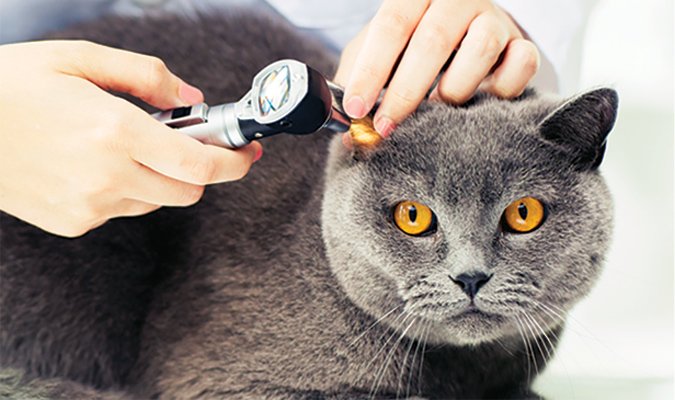When it comes to ears, there’s a “Big Four” of common problems, says William H. Miller Jr. VMD DACVD, Professor of Medicine, Section of Dermatology, Medical Director, Cornell University Hospital for Animals:
-Ear mites, especially for young cats with bilateral disease
-Inflammatory polyp, likely offender in a young cat with one ear involved
-Bilateral otitis, common in older cats, especially with allergies
-Unilateral otitis, due to a tumor or foreign body in the ear canal.
Ear Mite Infestation
Although kittens battle more than their fair share, mites can infest cats of any age. Mite infestations comprise 50 percent of all feline ear problems.
What It Is: Ear mites (Otodectes cynaoti) are an external parasite with a predilection for ears, although they can live on a cat’s neck and head as well. They also infest dogs and wildlife like foxes (but they’re not the common species found in rabbits). Dogs and cats can share these mites. Ear mites don’t jump or run like fleas—they walk from one pet to another. If one pet is diagnosed with ear mites, treat all the pets in the family.
Cats can have as many as 1,000 mites in one ear. Sheer numbers lead to irritation, for sure, but some cats react more strongly than others. While mites may be seen with the naked eye, they are usually observed through a veterinary otoscopic exam or under a microscope.
Symptoms: Cats with ear mites shake their heads, paw at their ears, hold their ears at unusual angles, and/or rub their heads and ears. Usually, both ears are infested. You may see a buildup of dark wax or cerumen in the ears (looks like coffee grounds) and sometimes blood due to the cat scratching her ears.
Treatment: Many topical flea and tick medications kill ear mites. Start by cleaning the ear carefully (see July 2018 “Have You Heard?” available at catwatchnewsletter.com) and removing as many mites as possible. Your veterinarian may give you ear drops, especially if there is a secondary infection.
Ear Polyp
Polyps occur most frequently in cats 8 to 12 months of age, usually after a respiratory illness. What causes a polyp remains a debate, but viral respiratory infections are strongly suspected.
What It Is: An ear polyp is a benign growth that starts in the middle ear. Ear polyps can present in many ways (see also “When a Nasopharngeal Polyp Makes an Appearance,” February 2018, at catwatchnewsletter.com), and they usually need to be removed. A polyp can interfere with breathing if it grows back up the Eustachian tube, which is a canal that connects the middle ear with the nasopharynx. Other polyps may grow in the ear canal itself, and some may jeopardize the ear drum.
Symptoms: Cats will exhibit respiratory problems, like sneezing. They may shake their heads, paw at ears, and display a head tilt. If a polyp pushes on the middle ear, you may notice the cat has difficulty walking due to a polyp-induced balance problem.
Treatment: Sedation is often required to diagnose a polyp. Polyps in the ear canal are found on otoscopic examination, and sometimes steady traction will bring the polyp down, stretch it, and break the stalk. In rare cases, the polyp may have grown up around the bulla of the ear. Removal of these polyps requires more extensive surgery. Most polyps are benign, and removal is generally curative, but occasionally a polyp will grow back.

Syda_Productions | Deposit Photos
Otitis (Ear Infection)
Most ear infections start as otitis externa, which means the infection is limited to the external part of the cat’s ear. Left untreated, it can spread farther into the ear. Otitis media (infection in the middle ear) or otitis interna (infection in the inner ear) can lead to deafness.
What It Is: Otitis is an infection that causes an overproduction of earwax and tissue damage. It can progress to a painful ruptured ear drum. Otitis media may cause vestibular signs, like head tilting.
Symptoms: Headshaking, a bad odor, and scratching are the usual initial symptoms. Itchy, red, and inflamed ears may be due to allergies, like atopy (allergic dermatitis), a reaction to inhaled allergens like pollen.
Treatment: A swab of the debris will be taken for examination under a microscope. The ear will be cleaned, and medicated drops or ointment will be prescribed. If allergy-related, treatment may include looking for the cause. Secondary problems, such as bacterial (smelly purulent discharge) or yeast (very inflamed, moist ears, possible clear discharge) infections, will be treated.
Depending on severity and the type of bacteria or fungus involved, your cat may need oral antibiotics as well as topical ear ointments or drops. Oral corticosteroids may be needed initially for relief.
Luckily, most cats go through life without ear problems. But if your cat shows any discomfort around her ears or any discharge from the ear, have a veterinarian examine her promptly.
Less Common Ear Illnesses and Complications
Severe Infections: Severe infections, whether bacterial, fungal, or mite-induced, may require sedation to do a deep ear cleaning. Some cats will show temporary vestibular signs, like a head tilt, after a deep flushing.
Hematoma: A side effect of ear mites and/or ear infections can be a hematoma. When scratching at the ear or vigorously shaking her head, your cat might cause blood vessels in the ear to rupture. As these bleed, they fill the limited space between the planes of cartilage in the ear, resulting in a painful, warm, and grossly swollen ear. “Hematomas will resolve spontaneously, but the pinna will tend to crinkle as the hematoma contracts. To prevent pinnal (outer ear) damage, the hematoma can be drained, and compression bandaged if the cat will tolerate a bandage. Surgery can be done to remove the clot once the bleeding has stopped,” says Dr. Miller.
Foreign Bodies: Bugs, seeds, and plant material like foxtail awns can migrate into an ear. Some foreign bodies can be flushed out, though sedation may be required. Others require forceps to retrieve the offending foreign body.
Cancer: An adult cat with just one ear affected may have a cancerous growth. Secondary infections can cause a bad odor and purulent discharge. Squamous cell carcinomas can be seen on white ears with growth related to sun exposure. Superficial cancers caught early may be removed. Other cancers may grow down in the ear canal where usually they aren’t caught early.
Cerumen Cysts: Caused by blocked oil glands, these cysts may appear bluish or dark in color. These are benign. However, they sometimes get big enough to limit airflow in the ear and need to be removed.




